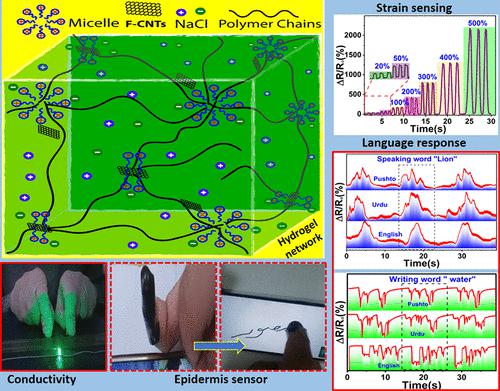当前位置:
X-MOL 学术
›
ACS Appl. Polym. Mater.
›
论文详情
Our official English website, www.x-mol.net, welcomes your feedback! (Note: you will need to create a separate account there.)
Multiple-Language-Responsive Conductive Hydrogel Composites for Flexible Strain and Epidermis Sensors
ACS Applied Polymer Materials ( IF 5 ) Pub Date : 2024-03-22 , DOI: 10.1021/acsapm.4c00327 Mansoor Khan 1 , Luqman Ali Shah 1 , Tanzil Ur Rahman 1 , Latafat Ara 1 , Hyeong-Min Yoo 2
ACS Applied Polymer Materials ( IF 5 ) Pub Date : 2024-03-22 , DOI: 10.1021/acsapm.4c00327 Mansoor Khan 1 , Luqman Ali Shah 1 , Tanzil Ur Rahman 1 , Latafat Ara 1 , Hyeong-Min Yoo 2
Affiliation

|
Conductive hydrogels are considered highly promising materials for developing skin-like sensors due to their excellent biocompatibility and mechanical flexibility. However, their limited stretchability, low toughness, and low fatigue resistance hinder their sensing capabilities and durability. To overcome these limitations, we developed a conductive hydrogel composite with high mechanical performance and the ability to respond to and identify different languages. The hydrogels are prepared by incorporating functionalized multiwalled carbon tubes (F-CNTs) into hydrophobically associated polyacrylamide (AM) and lauryl methacrylate (Lmc) hydrogels. To ensure the uniform dispersion of F-CNTs in the hydrogel network, the cationic surfactant cetyldimethylethylammonium bromide (CDAB) is used; the carboxylic group on F-CNTs cross-links the micelles and polymer chains through electrostatic interactions. The surfactant also facilitates the formation of hydrophobic interactions between the hydrogel matrix and the F-CNT surface. This greatly improves the mechanical properties of the hydrogel, resulting in excellent stretchability of 2016%, a toughness of 551.56 kJ m–3, and an antifatigue property. The hydrogel also exhibits high tensile strain sensitivity with a gauge factor of 4.69 at 600% strain. The hybrid hydrogel-based sensors demonstrate excellent sensing capabilities, not only detecting full-range human activities but also differentiating different languages (English, Urdu, and Pushto) in both speaking and writing. Besides strain sensing, the hybrid hydrogel has the capability to mimic human skin for a touchable screen like a metal. These results highlight the potential of the F-CNT-based hybrid hydrogel as a wearable strain sensor for flexible devices.
中文翻译:

用于柔性应变和表皮传感器的多语言响应导电水凝胶复合材料
由于其优异的生物相容性和机械灵活性,导电水凝胶被认为是开发类皮肤传感器的非常有前途的材料。然而,它们有限的拉伸性、低韧性和低抗疲劳性阻碍了它们的传感能力和耐用性。为了克服这些限制,我们开发了一种导电水凝胶复合材料,具有高机械性能以及响应和识别不同语言的能力。该水凝胶是通过将功能化多壁碳管(F-CNT)掺入疏水缔合的聚丙烯酰胺(AM)和甲基丙烯酸月桂酯(Lmc)水凝胶中来制备的。为了确保F-CNT在水凝胶网络中均匀分散,使用了阳离子表面活性剂十六烷基二甲基乙基溴化铵(CDAB); F-CNT 上的羧基通过静电相互作用交联胶束和聚合物链。表面活性剂还促进水凝胶基质和F-CNT表面之间疏水相互作用的形成。这极大地提高了水凝胶的机械性能,使其具有2016%的优异拉伸性、551.56 kJ m –3的韧性和抗疲劳性能。该水凝胶还表现出高拉伸应变敏感性,600% 应变时的应变系数为 4.69。基于混合水凝胶的传感器表现出出色的传感能力,不仅可以检测全方位的人类活动,还可以区分不同语言(英语、乌尔都语和普什图语)的口语和写作。除了应变传感之外,混合水凝胶还能够模仿人类皮肤,用于像金属一样的可触摸屏幕。这些结果凸显了基于 F-CNT 的混合水凝胶作为柔性设备的可穿戴应变传感器的潜力。
更新日期:2024-03-22
中文翻译:

用于柔性应变和表皮传感器的多语言响应导电水凝胶复合材料
由于其优异的生物相容性和机械灵活性,导电水凝胶被认为是开发类皮肤传感器的非常有前途的材料。然而,它们有限的拉伸性、低韧性和低抗疲劳性阻碍了它们的传感能力和耐用性。为了克服这些限制,我们开发了一种导电水凝胶复合材料,具有高机械性能以及响应和识别不同语言的能力。该水凝胶是通过将功能化多壁碳管(F-CNT)掺入疏水缔合的聚丙烯酰胺(AM)和甲基丙烯酸月桂酯(Lmc)水凝胶中来制备的。为了确保F-CNT在水凝胶网络中均匀分散,使用了阳离子表面活性剂十六烷基二甲基乙基溴化铵(CDAB); F-CNT 上的羧基通过静电相互作用交联胶束和聚合物链。表面活性剂还促进水凝胶基质和F-CNT表面之间疏水相互作用的形成。这极大地提高了水凝胶的机械性能,使其具有2016%的优异拉伸性、551.56 kJ m –3的韧性和抗疲劳性能。该水凝胶还表现出高拉伸应变敏感性,600% 应变时的应变系数为 4.69。基于混合水凝胶的传感器表现出出色的传感能力,不仅可以检测全方位的人类活动,还可以区分不同语言(英语、乌尔都语和普什图语)的口语和写作。除了应变传感之外,混合水凝胶还能够模仿人类皮肤,用于像金属一样的可触摸屏幕。这些结果凸显了基于 F-CNT 的混合水凝胶作为柔性设备的可穿戴应变传感器的潜力。



























 京公网安备 11010802027423号
京公网安备 11010802027423号